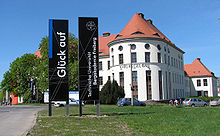Freiberg University of Mining and Technology
 | |
| Motto | The University of Ressorces. Since 1765. |
|---|---|
| Established | 1765 |
| Chancellor | p.p. Jens Then |
| President | Prof. Klaus-Dieter Barbknecht |
| Students | 4927(WS 2015/16)[1] |
| Location | , |
| Website | tu-freiberg.de |

The Technische Universität Bergakademie Freiberg (usually translated from German as Freiberg University of Mining and Technology or Freiberg Mining Academy, University of Technology) is a German university of technology with about 5000 students in the city of Freiberg, Saxony. It was established in 1765 by Prince Franz Xaver, regent of Saxony, based on plans by Friedrich Wilhelm von Oppel and Friedrich Anton von Heynitz, and is the oldest university of mining and metallurgy in the world. The chemical elements indium (1863) and germanium (1886) were discovered by scientists of Freiberg University. The polymath Alexander von Humboldt studied mining at the Bergakademie Freiberg in 1791/1792. Today, TU Bergakademie Freiberg is a university of technology comprising six faculties: mathematics and informatics; chemistry, biology and physics; geoscience, geoengineering and mining; mechanical engineering; material sciences; and economics. Admission to all programs from Bachelor through PhD is without tuition fees; students pay only a registration fee of about € 84 per semester.
References
External links
- Website of the Freiberg University of Mining and Technology (German)
- Website of the International Center 'Alexander von Humboldt'
50°55′05″N 13°20′27″E / 50.91806°N 13.34083°E
